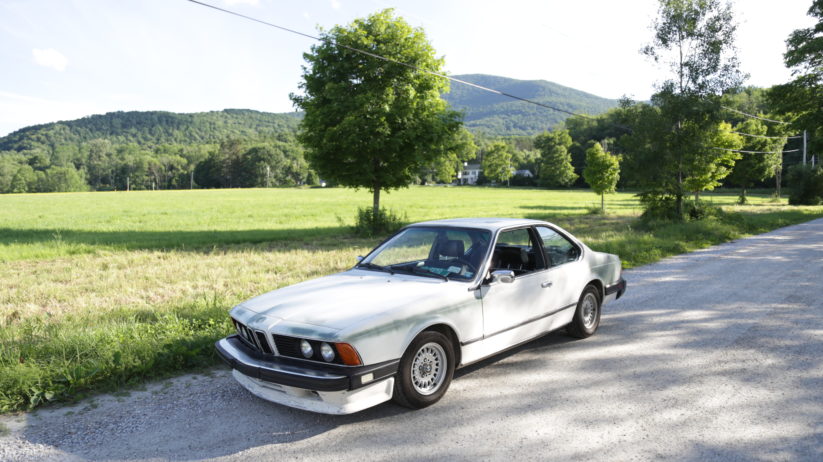We can’t have a win every time. Try as we might to find a good car, the annals of Craigslist and Facebook Marketplace—even dealerships themselves—are ripe with cars that have had a hard life… and an even harder present: bad cars, rough cars, neglected cars. There are plenty of diamonds in the rough—objects of lust for car-flippers—but that still leaves piles upon piles of vehicles best left untouched.
But in my travels with the BMW Car Club of America, and among friends with high standards, I’ve come to the realization that there are some people who have never experienced a Truly Bad Car. Sometimes they apply this label following an above-average number of warranty claims, or following a history of bad luck and flat tires. Sometimes it means a cumbersome infotainment system, or a seat-adjustment arm that pinches your hand every time. But these things, all certainly flaws, do not create a Truly Bad Car.
Which brings me to my 1985 BMW 635CSi.
To be fully transparent, this was not exactly my car, since I shared possession, although I do take responsibility for its unfortunate acquisition. It was during high school, and the co-owner was BMW enthusiast and occasional BimmerLife contributor Nick Parente. For reasons not worth explaining, for a couple months we had been in possession of a free Mercedes-Benz E320 wagon, a black-over-tan S124 with 200,000 miles… and no reverse gear.
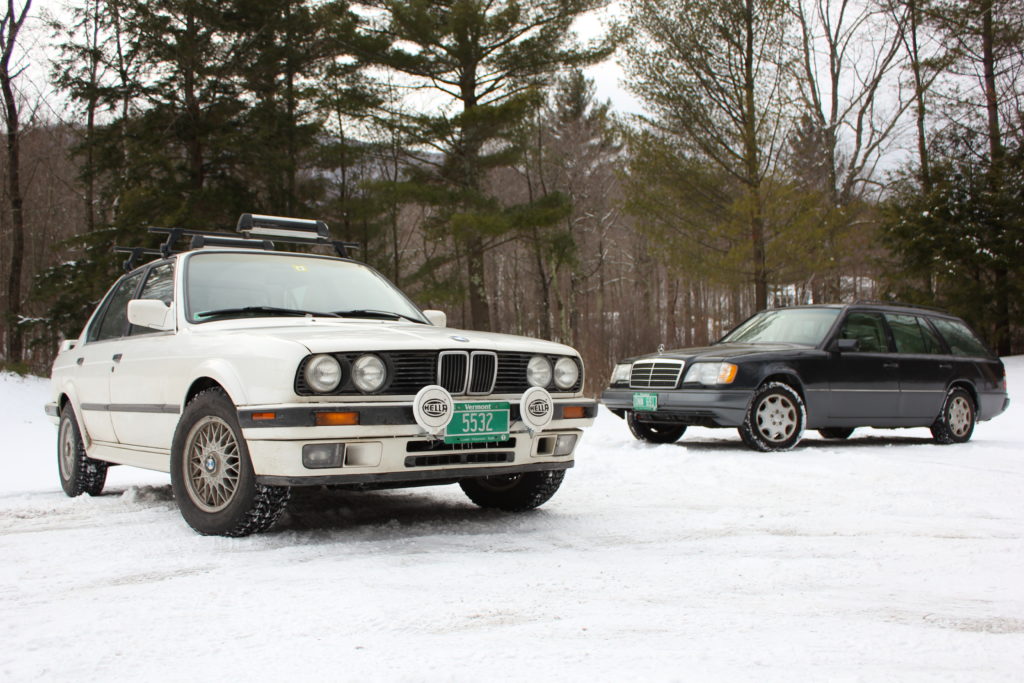
Nick’s BMW 325iX alongside our 1994 Mercedes-Benz E320: I’ve since owned five more W124-chassis Mercedes, and have traded none of them.
Since we had other aging German cars, and numerous friends with Saabs, the E320 acted as a sort of loaner car when someone’s car was down for repairs or maintenance. It had its flaws, certainly; there was the occasional limp-home mode sortie, and more than a few times it ended up parallel-parked facing downhill, at which point it had to be pushed backward by hand or remain trapped. But in our untarnished imaginations, the clock was set to replace it with another project.
Anyone who has traded a car knows the ordeal that followed.
The old Benz, predictably, had no bites on Craigslist (despite our comically high asking price—who would have thought?). So out of classroom boredom, I began offering it to sellers of oddball vehicles on Craigslist who seemed open to a trade.
To esteemed collectors, trading cars is something of a respectable negotiation: “I’ll give you two M635CSi coupes for your restored E9 3.0CS.” However, at the sub-$4,000 level, it’s distinctly less so, a game of finding a vehicle flawed in different but equal ways to your own car. It’s the online dating of car sales, and you tend to be laughed at if you try to go above your league.
The options were dregs. Most people with clean Saabs or BMWs, which on paper were of the same value, did not want a twenty-year-old Mercedes. The same was true for everything from Suburbans to Hondas, and while we received numerous offers for motorcycles, our respective families had no patience for that discussion.
So the trade search became a race to the bottom—until I found the 6 Series.
Like most trade ads, the photos were far from clear. They were heavily-filtered Android photos that showed, more or less, a white 1985 BMW 635CSi. From the photos, we could tell that someone had done as many free modifications as they could; it was lowered, clearly, and most of its light lenses were covered in heavy tint. It sat on E39-spec Style 19s with black centers, and it was thoroughly beaten.
But hey, it was a 6 Series, and a manual. I had one, and loved it. My car was a 1986 model—similar enough, I thought—and stock, a beautiful Arktisblau on Pearlbeige sport pack, five-speed. It was a joy to own.
How bad could another be?
The transaction occurred at a New York DMV office. Parente and I drove there from Vermont, about an hour away, and we showed up early in the smooth, comfortable Benz. It was late, close to closing; it was the school year, and the sun was setting early.
We heard the E24 before we saw it. The seller had mentioned that it had “an exhaust,” but the reality is that it was straight-piped: true dual and running from the headers back to two inadequate glass-pack mufflers. There was a sticker by the exhaust, stained with soot, that read “Prius Repellent.”
It did not sound good.

Mid-paint preparation, still on the original (bent) wheels.
We got out of our Benz, which suddenly looked a lot nicer than it had that morning. The E24 was white, yes, but the trim had been painted black—and poorly. Paint was falling off everywhere. An enormous gash sliced across the rear quarter panel, where rust was forming. The lower dash panels were missing, and the interior was warm with heat from the console. It had a start button, the result of a broken ignition cylinder.
Parente gave me a side-eye to all these details, but we were seventeen, and all we saw was a manual transmission—and a reverse gear—and resale potential. By the time we’d gotten our temporary plates from the DMV, the idiocy of our endeavor had not yet set in.
It set in quickly once we pulled onto the road.
The car was a pile of garbage. The suspension had been lowered, yes—on cut springs and factory shocks. It had no damping or rebound, and rubbed the tires constantly. The oil pan was low enough that you could lean an iPhone 4 on it, sideways. The exhaust scraped on intersections. It was unsurprising, then, that we quickly found that all four wheels were bent, sending shimmies through the deteriorating steering wheel. The exhaust was deafening; an unbearable drone until it became a wayward scream above 4,000 rpm.
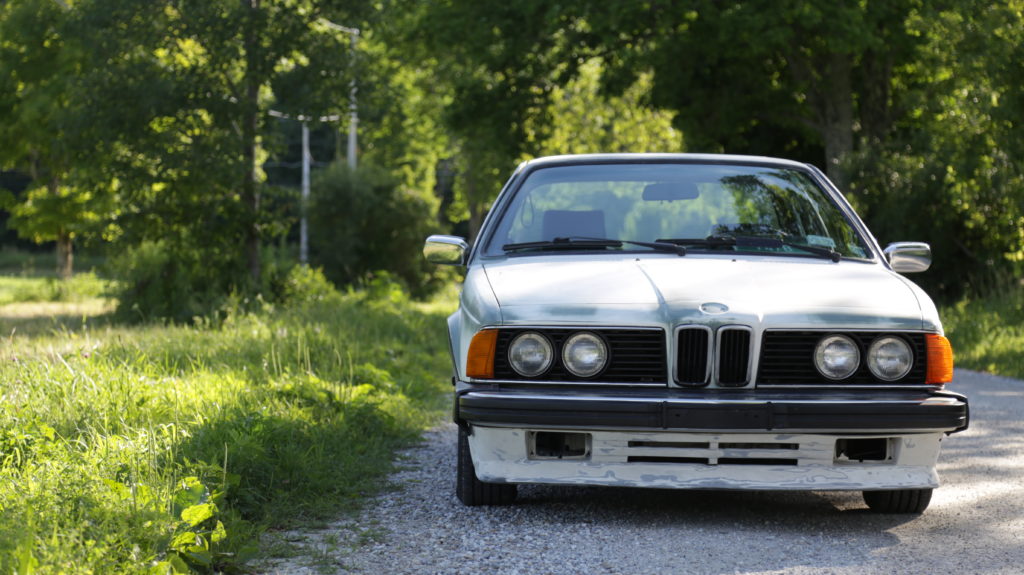
After paintwork had begun on the white E24 project.
The ride to the DMV took an hour; the ride home took three. A closed bridge put us on dirt roads, too, with no service and constant scraping of the exhaust. There were probably other flaws with the car to notice—the cracked dash, glass shards on the rear seat, various clanks and groans—but we were too alarmed by the wandering suspension to take much notice of them.
This harrowing journey home would be the only time we really drove the car.
In the light of the next morning, the car was assessed. We had planned from the beginning to do the suspension, but now the decrepit body was added to the list. Being unfamiliar with Truly Bad Cars, we decided that we should disassemble and paint it.
Over the next months in Parente’s garage, the car was stripped, sanded, and primed for paint. We discovered that it had been sprayed four times. The new shocks and struts—Bilstein Sports and H&R springs—qwew installed. Friends stopped in to laugh, and occasionally to help. We peeled off the big coupe’s questionable stickers.
We took it for a test drive once, when the suspension was complete. The alternator wasn’t charging, so we stuck a jump pack under the hood. A wheel fell off on the side of the road, in the Vermont snow. I lent the car my mesh wheels, but had second thoughts and grabbed a cheap set of bottlecap wheels from an E28 528e; this car didn’t deserve good wheels.
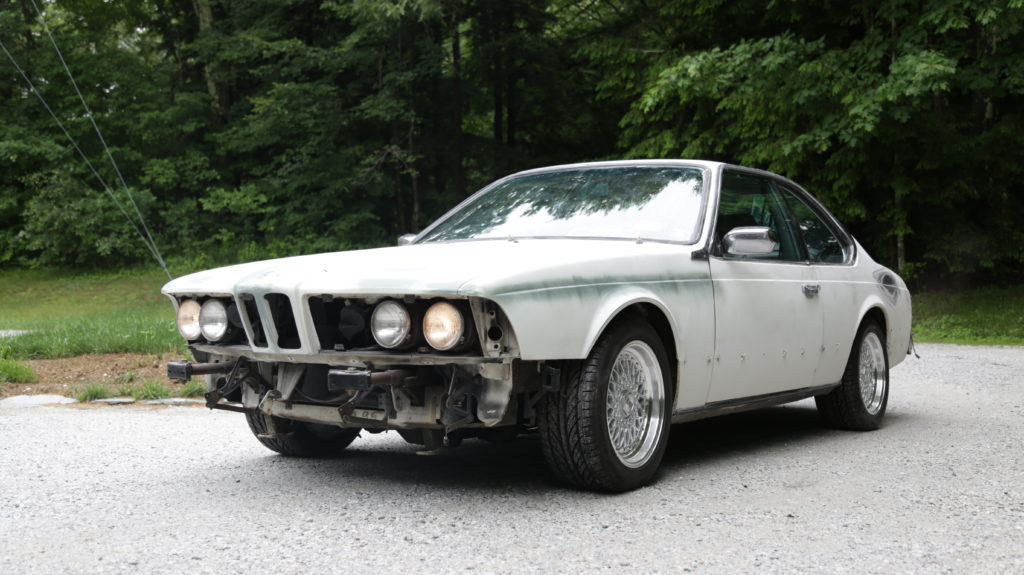
A shark with no jaw.
In the end, it didn’t deserve our attention, either.
You see, the E24 came with paperwork, and in that history, a secret was revealed: Some time in Florida, long before it came up to rust in New Jersey and New York, the car had hit something in the road. Parente and I were clued into this when we found junkyard writing on the front crossmember, but the receipts told a different story. Somehow the engine had plowed into something and been pushed back, along with the entire drivetrain. This car would never feel right, under any circumstances, no matter how many name brands we threw at it.
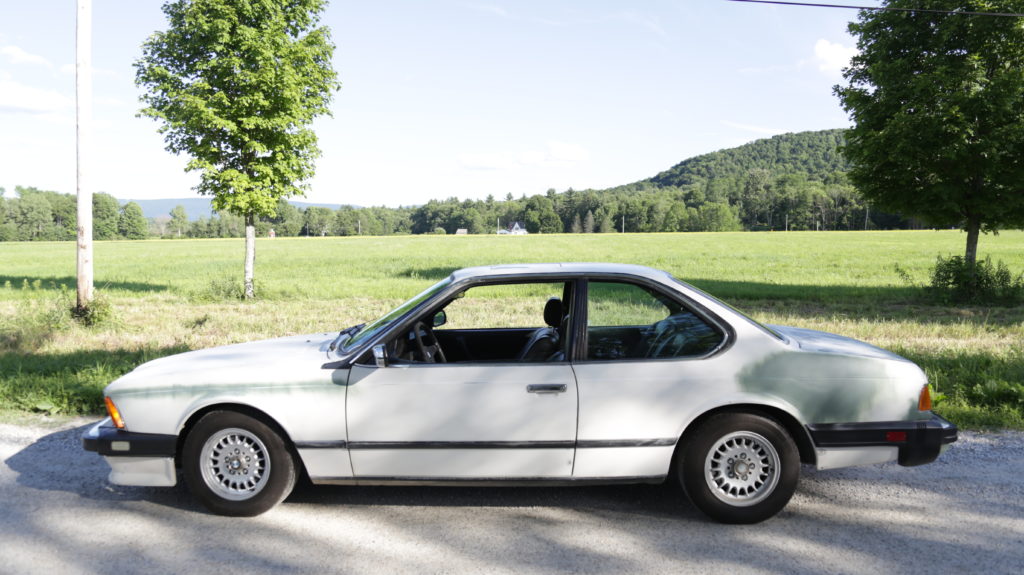
The E24, as we traded it away.
There is a quality I’ve come to understand about Truly Bad Cars. They are not necessarily broken cars, although the white E24 was certainly broken. Instead, they are cars of no redeeming value; a Truly Bad Car is a car that no longer functions as even a parts car.
In the end, there wasn’t a single part from the white car that I would have wanted on my blue car, and thanks to a mid-year changeover in 1985, many wouldn’t have fit anyway. Combined with the history of drivetrain relocation, the four layers of paint, and the long-missing plastic, it was a basket case, never worth restoring—ruined by time and misfortune, and irreparably so.
Exasperated, we traded the E24 again—unpainted, but running—the next summer, this time for a 210,000-mile Lexus. The Lexus ran smoothly. The a/c was ice-cold. The flaws with the 635CSi were listed, and the buyer wanted to build a drift car out of it. We wished him luck.
When I ran the VIN last year, the big coupe hadn’t been registered since 2014.
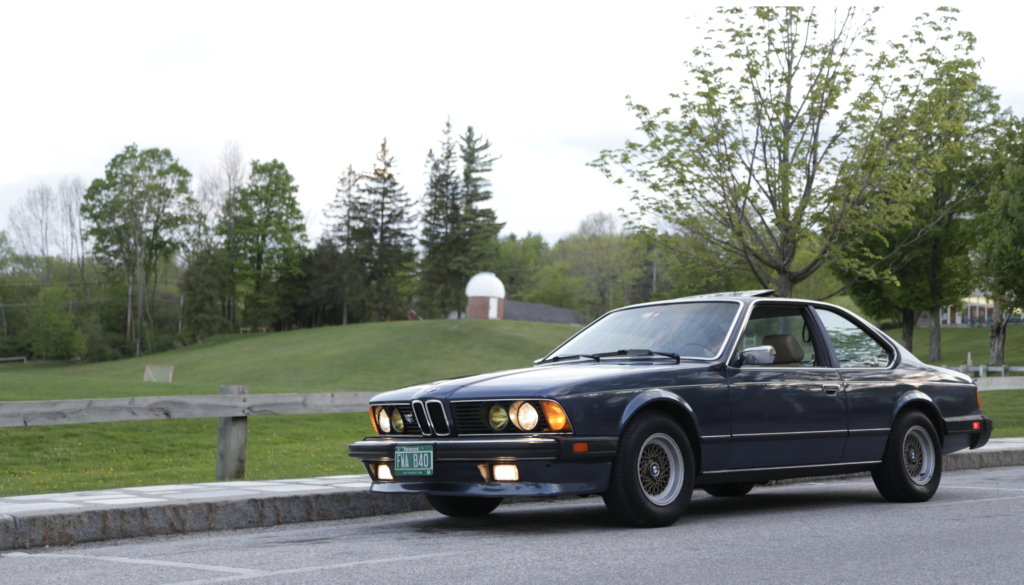
My “good” E24, a 1986 635CSi five-speed, circa 2013.
Parente went on to focus on building his E30 325iX—a Truly Good Car—and I kept my blue E24, somewhat more patient with its now-minor flaws. We’re now approaching a decade from our time with the white E24, and we’re cynical in our mid-to-late-twenties. We’ve moved on to better cars, skeptical of ownership history and shoulder-shrug repairs.
These days, when people send us ads for long-neglected projects, we tell them to be wary. But the truth is, it’s impossible to explain in definitive terms what makes a Truly Bad Car; you simply have own one to know.—David Rose
[Photos courtesy David Rose.]

